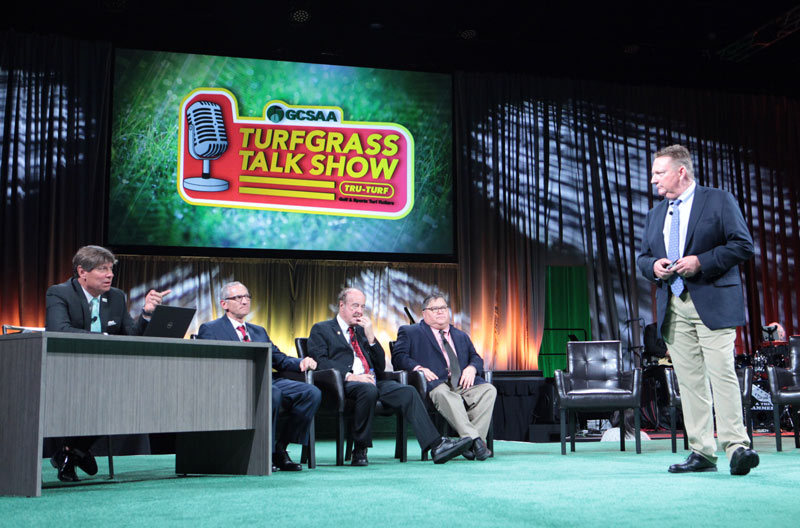
Look who’s talkin’ turf (from left): Turfgrass Talk Show host Thom Nikolai, Ph.D.; Dale Bremer, Ph.D.; Joe Vargas, Ph.D.; Roch Gaussoin, Ph.D.; and Matt Taylor, CGCS. Photo by Roger Billings
When it comes to changes on golf courses, advances in irrigation technology may be No. 1 on the radars of superintendents. A range of topics related to irrigation were covered at the 2020 Turfgrass Talk Show, which featured a panel of five Ph.D.s, two certified golf course superintendents, one president of the American Society of Golf Course Architects, and longtime Turfgrass Talk Show host Thom Nikolai (another Ph.D.). Altogether, the group likely has, at the least, a combined 200 years of experience in irrigation.
Here are some highlights and key takeaways:
• Presenters offered something old — architect Jan Bel Jan’s history of irrigation revealed that King Hammurabi (1792-1750 B.C.) developed the first regulations governing irrigation — and something new — Kansas State University’s Dale Bremer, Ph.D., reported that drones can be used along with thermal imaging to detect, among other things, drought stress in plants.
• Mike Morris, CGCS, from Crystal Downs Country Club in Frankfort, Mich., shared advice for how to move an irrigation project forward: Start with the “why” — inform your stakeholders why your course needs a new irrigation system instead of what the system is going to be.
• Matt Taylor, CGCS, from Royal Poinciana Golf Club in Naples, Fla., advocated for the use of effluent water, which is the irrigation of choice for 76% of the golf courses in Florida. “Effluent may be the way we can keep a lot of places going (in Florida),” Taylor said.
• Roch Gaussoin, Ph.D., reminded the audience that only 2.5% of the water on the planet is fresh water, and that golf courses can be leaders in water conservation practices by seizing upon the potential of effluent water.
• Michigan State University turfgrass legend Joe Vargas, Ph.D., confessed that, for years, he had told superintendents that nighttime irrigation would have terrible consequences and would most likely lead to dollar spot infection. Research ultimately showed the opposite to be true: Watering nightly does not produce dollar spot, but deep, infrequent watering does cause disease. This outcome emphasizes the importance of research, which can definitively show whether commonly held beliefs are actually correct, said Vargas.
• Taking a break from playing in the rhythm section of the Turfgrass Talk Show’s house band, Dave Kopec , Ph.D., emeritus professor at the University of Arizona, discussed the importance of uniformity in golf course irrigation and how to get it and measure it.
• From the Midwest, the University of Missouri’s Lee Miller, Ph.D., discussed his ongoing research — funded in part by the EIFG and the USGA — on whether spores in the irrigation system could contribute to the proliferation of pythium root rot in turfgrass.
Teresa Carson is GCM’s science editor.